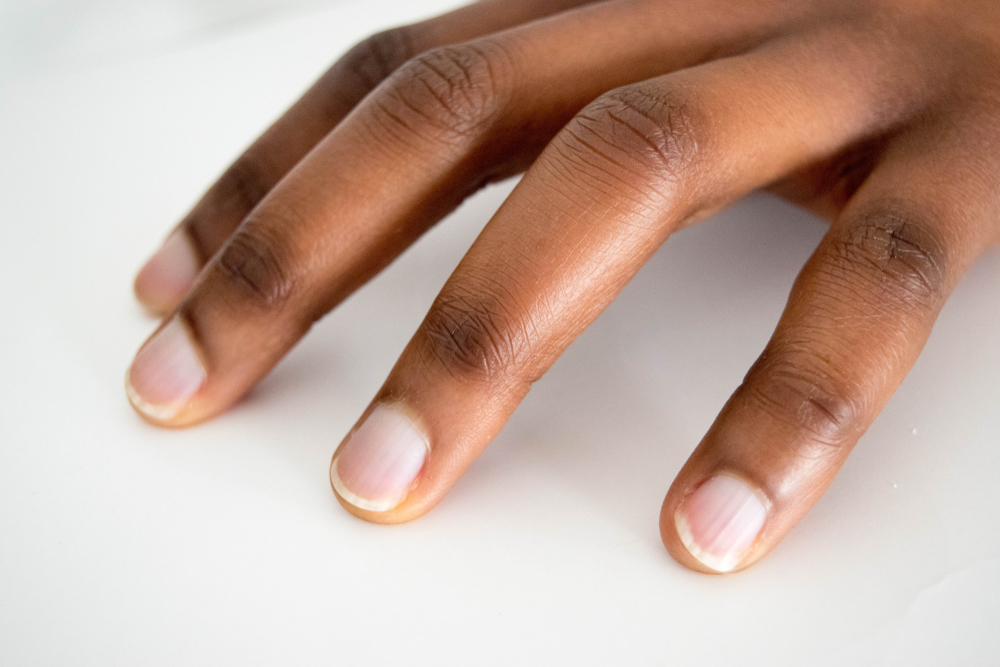Those seemingly innocent changes in your nails might be telling you something important about what’s happening deep inside your body. While most of us only pay attention to our nails when it’s time for a manicure or when one breaks inconveniently, these small keratin structures serve as surprising windows into your internal health—particularly when it comes to your liver.
Your liver performs over 500 essential functions, from filtering toxins to producing vital proteins for blood clotting. When this powerhouse organ experiences stress or damage, the effects often appear in unexpected places long before obvious symptoms develop. Your nails, continually growing and visible without medical equipment, frequently display these early warning signs months before conventional tests detect problems.
Let’s explore how these tiny keratin canvases might be broadcasting important messages about your liver health that you never knew to look for.
The pale nail transformation
One of the earliest and most subtle indicators of potential liver stress appears as a gradual lightening of the nail bed. Healthy nails typically have a pinkish hue due to the rich blood vessels beneath the translucent nail plate. When your liver function begins to decline, this characteristic pink color often fades to a paler shade.
This paleness occurs because liver stress affects how your body processes proteins, including those involved in red blood cell production and function. With fewer functioning red blood cells delivering oxygen to your nail beds, the vibrant pink color begins to wash out, sometimes appearing almost white in more advanced cases.
What makes this sign particularly valuable is how early it can appear—often when blood tests still show liver function within normal ranges. The nail bed requires excellent circulation and oxygenation to maintain its color, making it sensitive to even slight disruptions in the proteins your liver produces to support blood health.
Pay particular attention if this nail paleness appears alongside mild fatigue or slight yellowish tones in the whites of your eyes. Together, these subtle changes often signal early-stage liver stress that’s still highly responsive to lifestyle interventions before permanent damage occurs.
The rippled surface warning
Smooth, even nail surfaces are hallmarks of good health. When liver function becomes compromised, nails frequently develop subtle textural changes that feel rough to the touch or appear slightly rippled when caught in certain light.
These texture changes stem from your liver’s crucial role in protein synthesis and nutrient processing. When liver cells experience stress, the production of keratin—the primary protein in nails—becomes irregular. Instead of forming the smooth, consistent layers that create a glassy nail surface, the keratin deposits unevenly, creating microscopic ridges and valleys.
The pattern of these ripples can sometimes provide clues about the nature of the liver stress. Horizontal ripples or waves often suggest periodic liver strain, perhaps from medication use or fluctuating toxin exposure. Vertical ridges, while sometimes just a sign of aging, can indicate more persistent nutritional processing issues related to chronic liver stress.
This textural change typically precedes more obvious nail problems and often goes unnoticed without deliberate attention. Running your fingertip gently across your nail surface can reveal subtle irregularities that aren’t immediately visible—an easy self-check that costs nothing yet might detect liver issues months before other symptoms appear.
The mysterious white bands
Perhaps the most distinctive nail change associated with liver stress is the appearance of horizontal white bands or lines across the nail plate. Known medically as “Muehrcke’s lines,” these pairs of whitish bands run parallel to the nail’s lunula (the white half-moon at the nail base) and, crucially, don’t move as the nail grows.
Unlike other nail markings that grow out with the nail, these distinctive bands result from changes in the nail bed beneath rather than in the nail plate itself. They develop when your liver struggles to produce albumin—a critical protein that maintains proper fluid balance throughout your body, including in the tiny blood vessels of your nail bed.
When albumin levels fall due to liver stress, these small blood vessels function abnormally, creating visible white bands where blood flow is disrupted. Interestingly, these bands might temporarily disappear when you press on the nail, only to return when pressure is released—a distinguishing feature of this specific liver-related nail change.
These white bands often appear before other noticeable symptoms of liver dysfunction, potentially providing months of early warning. If you notice these distinctive markings, especially alongside mild digestive changes or unusual fatigue, it’s worth discussing with your healthcare provider, as they can indicate liver stress that blood tests might not yet detect.
The blue nail phenomenon
A bluish tint to the nails, particularly noticeable under the nail beds or as subtle blue streaks across the nail plate, often signals compromised oxygen transport—a function intimately connected to liver health through multiple pathways.
This bluish discoloration, called cyanosis, develops when your liver can’t effectively process certain compounds that affect how oxygen binds to and is transported by your red blood cells. The liver normally filters various substances from your blood that would otherwise interfere with oxygen binding to hemoglobin. When liver function declines, these compounds accumulate, reducing oxygen transport efficiency.
Additionally, liver stress often leads to changes in blood vessel dilation and constriction patterns, affecting blood flow to your extremities, including your fingertips. This circulatory change further contributes to the bluish appearance by allowing more deoxygenated blood to remain visible in the nail beds.
The blue nail sign warrants particular attention when it appears in multiple nails simultaneously or develops gradually over weeks or months rather than appearing suddenly. Gradual onset typically suggests an underlying systemic issue like liver stress, while sudden blueness more often indicates circulatory or respiratory problems requiring immediate medical attention.
The terry’s nail connection
A particularly telling nail pattern called “Terry’s nails” appears as an unusual reversal of normal nail coloration. In this condition, the nail bed becomes mostly white while the tip develops a distinctive reddish-brown band about 1-2mm wide.
This distinctive pattern develops because liver stress affects ground substance production—the specialized tissue that supports and nourishes the nail bed. As liver function declines, changes in protein production alter this supporting tissue, creating the characteristic white appearance of the nail bed while leaving a narrow band of normal circulation visible at the tip.
What makes Terry’s nails particularly significant is their strong association with cirrhosis—advanced scarring of the liver. However, early versions of this pattern, where the whiteness covers only part of the nail bed or appears less opaque, can signal liver stress at earlier, more treatable stages.
The appearance of even partial Terry’s nail changes warrants prompt medical evaluation, as this pattern has among the strongest correlations with significant liver conditions. When caught in its developing stages, this nail sign might provide crucial months of warning before more serious symptoms emerge.
The reddened half-moon shift
The small, typically white half-moon (lunula) visible at the base of your nails can undergo subtle color changes that signal specific types of liver stress. When this area develops a reddish or pinkish hue, it often indicates inflammation affecting liver function.
This reddening occurs because the lunula, normally less vascular than the rest of the nail bed, becomes more transparent to the underlying blood vessels when certain liver-produced proteins decline. Inflammation-related compounds also increase blood flow to this area, enhancing the reddish appearance.
The specific pattern of these lunula changes can sometimes suggest the nature of the liver issue. A reddened lunula with a particularly sharp border often associates with inflammatory liver conditions, while a more diffuse redness spreading beyond the lunula’s normal boundaries might indicate toxic stress to the liver.
This subtle sign is easy to overlook but provides valuable information when noticed. The lunula change frequently appears early in the development of liver issues, when interventions have the greatest chance of success, making this easily visible marker particularly valuable for preventive health monitoring.
The yellow nail transformation
A yellowish discoloration of the nails represents one of the more commonly recognized signs of liver stress, though many people mistake it for simple staining from nail polish or smoking. True liver-related yellowing has distinct characteristics that distinguish it from external staining.
This yellow transformation stems from bilirubin—a yellow compound produced when your liver breaks down old red blood cells. Normally, your liver processes bilirubin efficiently, but when liver function declines, this pigment accumulates in your bloodstream and eventually deposits in body tissues, including your nail beds.
Unlike external staining that affects primarily the surface, liver-related yellowing appears to come from within the nail and often shows a gradient effect—typically more intense near the base where the nail is newer and fading toward the tip. This pattern develops because newer nail growth reflects your current health status more accurately than older portions.
The significance of yellow nails increases when the discoloration appears in toenails as well as fingernails, persists despite not using nail polish, or develops alongside mild fatigue or digestive changes. This constellation of subtle findings often represents early liver stress that remains highly responsive to lifestyle modifications and targeted support.
The brittle nail mystery
Increasing nail brittleness—where nails crack, split, or break more easily than before—often signals nutritional processing issues related to early liver stress. While many factors can contribute to brittle nails, a pattern of progressive brittleness in previously healthy nails warrants special attention as a potential liver indicator.
This brittleness develops because optimal liver function is essential for processing the nutrients that maintain nail strength and flexibility. Proteins, biotin, zinc, and essential fatty acids all require proper liver processing to be utilized effectively for nail formation. When liver function declines, the structural quality of newly formed nail deteriorates, resulting in increased brittleness.
What distinguishes liver-related brittleness from other causes is often its progressive nature and resistance to topical treatments. While moisturizers and nail hardeners might temporarily improve symptoms, the brittleness quickly returns because the underlying metabolic issue remains unaddressed.
This sign deserves particular consideration when brittleness develops alongside subtle digestive changes like increased gas, mild bloating after fatty meals, or slight changes in stool color. Together, these subtle findings often point to early-stage liver stress that can be effectively addressed through dietary modifications and targeted support.
The clubbed nail progression
In more advanced stages of liver stress, some people develop a distinctive enlargement of the fingertips called clubbing, where the angle between the nail and nail bed gradually exceeds 180 degrees. However, subtle early stages of this process can be detected long before obvious clubbing appears.
This change begins with softening of the nail bed and increased sponginess of the tissue at the base of the nail. As liver function continues to decline, growth factors normally processed by the liver accumulate, stimulating tissue proliferation in the fingertips. Eventually, this creates the characteristic “floating nail” appearance where the nail seems to float above the digit rather than attaching firmly.
The earliest stage—increased sponginess at the nail base—can be detected by gently pressing on your nail. A healthy nail bed feels firm, while early clubbing changes create a spongy sensation when pressed. This simple self-check can identify potential liver issues months or even years before visible clubbing develops.
Pay particular attention to this sign if you’ve experienced risk factors for liver stress such as medication use, alcohol consumption, exposure to environmental toxins, or fatty liver. Early intervention when these subtle nail bed changes first appear offers the best opportunity to support liver health before more serious complications develop.
The relationship between your nails and liver health provides a valuable early warning system that’s literally at your fingertips. By understanding these subtle indicators and monitoring your nails with informed awareness, you gain access to information about your internal health that might otherwise require sophisticated medical testing to detect. This awareness empowers you to notice potential liver stress at its earliest, most reversible stages—when simple interventions can often restore optimal function before permanent damage occurs.

















